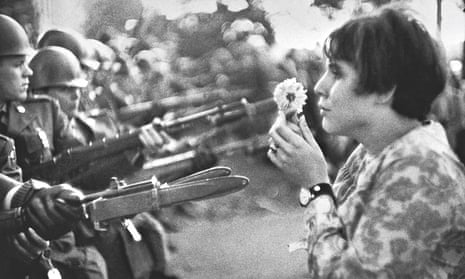I was 17 when this picture was taken, and by that point I was already dedicated to the anti-war movement. I felt that the war in Vietnam was a horrible expression of American imperialism and we had no business being there.
I went by myself to the march on the Pentagon, and when I arrived, everyone gathered around the Lincoln Memorial Reflecting Pool. As we walked to the Pentagon I fell in with a crowd who were chanting “Viva Che, Viva Che” – I didn’t even know what a Che was! I had never heard of Che Guevara.
As we approached the Pentagon, the National Guard lined up to form a barrier to keep us from encroaching. Somebody was handing out flowers, which is how I came to have a chrysanthemum in my hand. I was going back and forth, beckoning the soldiers to join us. It never dawned on me that I was in any danger. This was before Kent State, so who would ever think that they would kill me?
None of them made eye contact. They stonewalled me. But the photographer later told me he noticed them shaking. I think they were afraid they were going to be told to fire at us.
If you look at my face, I am extremely sad: at that moment I realised how young these boys were. They were just as much a victim of the war machine as anyone else. When I saw the picture exhibited for the first time, many years later, I teared up; it took me back to that overwhelming sadness.
I had no idea somebody had taken my photograph that day. I stayed at the protest until it got dark, and then took the bus home. To me, it was not a particularly eventful day.
It wasn’t until the 1980s that I discovered the photograph. My father had gone to Scotland and he bought a photography magazine, and he opened it to find his daughter in it. I wrote to Marc Riboud, the photographer, via Magnum, saying, “I’m the girl in the photo. I am not sure you care, but here is my address.” I didn’t hear back, and it wasn’t until I was in my 40s that people started getting interested in who I was, and news agencies started to contact me.
Looking back, it was a mind-blowing time – I was just 17. There were communists, White Panthers, Black Panthers, and many other factions. I didn’t know what to think. I led a major student strike on my campus at Montgomery College, in Maryland, but it all fizzled out.
I ended up dropping out of college because I couldn’t make sense of it all. I was a pre-med student, and I honestly think I would have been a doctor today if I hadn’t been involved in that movement. I am now a massage therapist and training to be a rabbi, as part of my quest to be a voice for peace. I threw away my college education because I took a stand.
It wasn’t until I saw the impact of this photograph that I realised it wasn’t only momentary folly – I was standing for something important.
Interview: Abigail Radnor
Are you in a famous photograph? Email weekend@theguardian.com

Comments (…)
Sign in or create your Guardian account to join the discussion